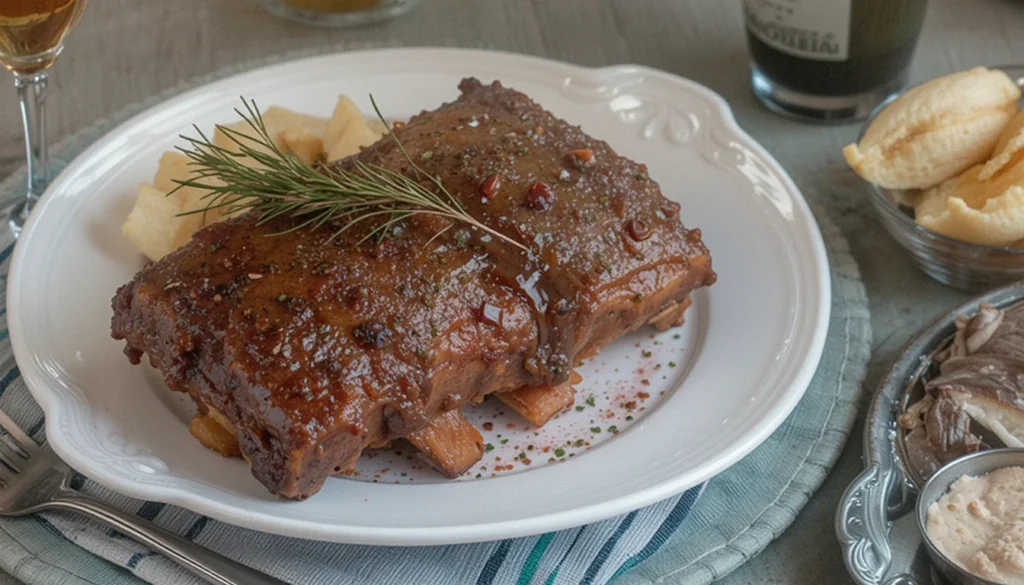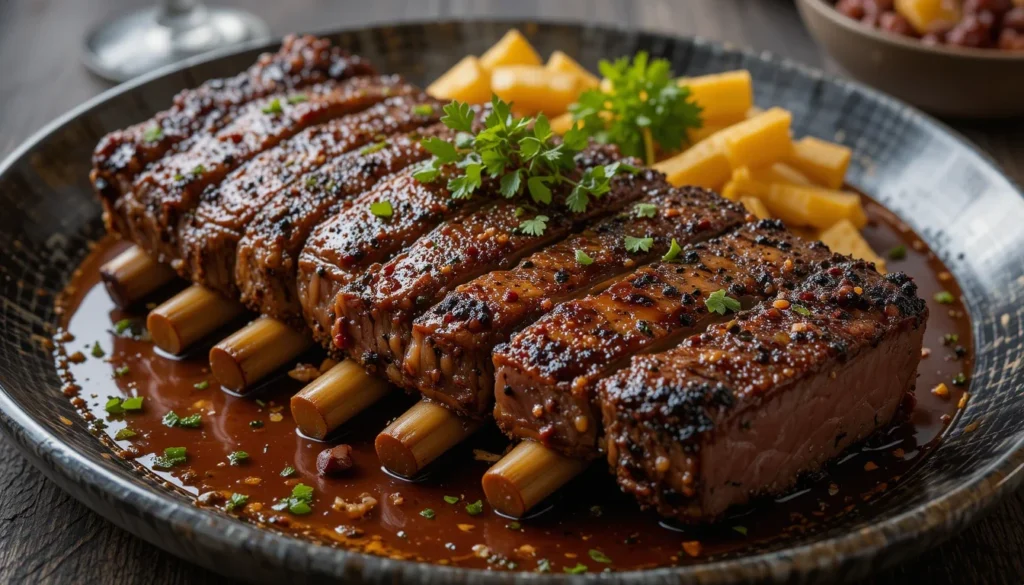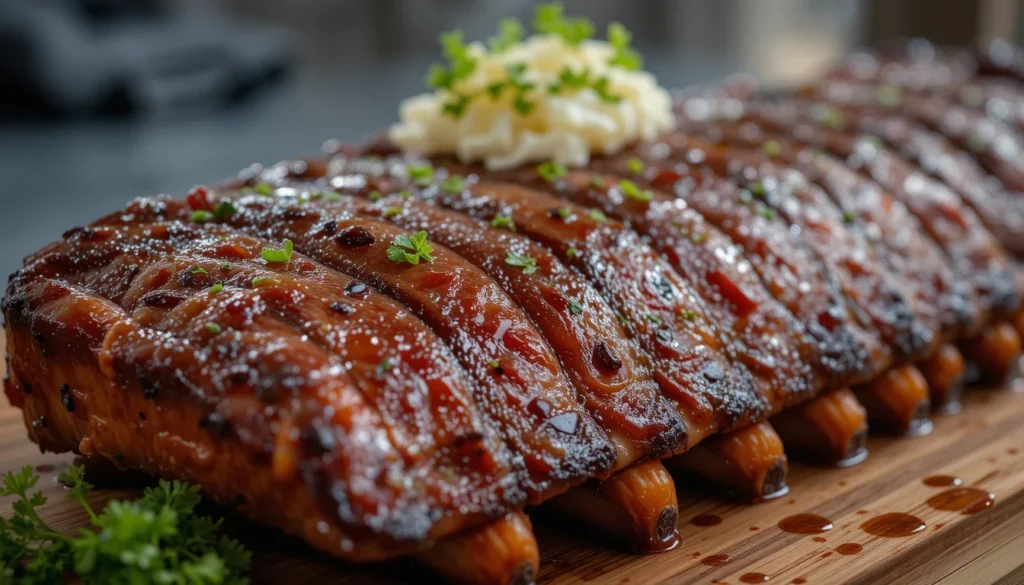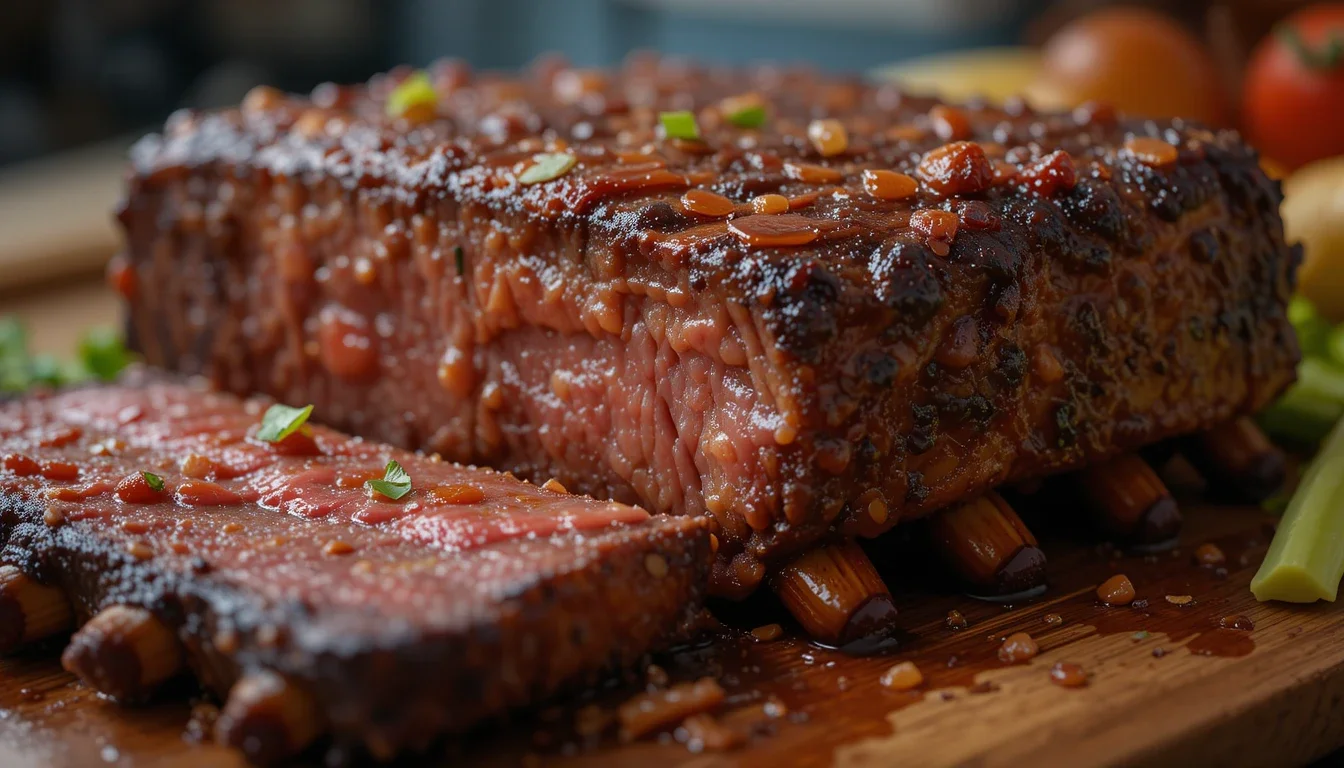Table of Contents
If you’re a BBQ enthusiast, you’ve probably heard of Dino Beef Ribs—the massive, meaty, and flavorful ribs that make a jaw-dropping centerpiece at any cookout. These ribs, often referred to as beef plate ribs, are known for their rich marbling, deep beefy flavor, and melt-in-your-mouth tenderness when cooked correctly.
Unlike pork ribs or baby back ribs, Dino Ribs offer an intense, beef-forward taste and are revered by pitmasters for their ability to hold up well in low and slow smoking techniques. These ribs can be intimidating due to their sheer size, but with the right preparation, seasoning, and cooking method, they deliver unparalleled tenderness and flavor.
In this guide, we’ll explore everything you need to know about Dino Beef Ribs, from choosing the best cuts to perfecting the smoking process. Whether you’re a seasoned pitmaster or a weekend griller, this article will help you master the art of cooking these legendary ribs.
What Are Dino Beef Ribs?
Dino Ribs come from the short plate section of a cow, just below the ribeye. They are thick, meaty, and often cut into three- or four-bone slabs, making them look prehistoric—hence the name “Dino Ribs.”
These ribs are sometimes confused with beef short ribs, but there’s a key distinction:
- Beef short ribs can come from the chuck section (which contains more connective tissue and requires longer cooking).
- Dino Ribs are taken from the plate section, where the meat is thicker, more tender, and packed with marbling.
Because of their exceptional marbling, Dino Ribs benefit from slow cooking methods such as smoking, braising, or sous vide cooking. If you want to understand more about beef marbling and its impact on flavor, check out this in-depth guide.
Why Are Dino Beef Ribs So Popular?
There’s a reason why Texas BBQ joints and pitmasters love Dino Beef Ribs:
- Huge meat-to-bone ratio – Unlike back ribs, these are loaded with tender, juicy meat that shrinks minimally during cooking.
- Perfect for low and slow cooking – Cooking at 225°F – 250°F for 8-10 hours creates fall-off-the-bone perfection.
- Incredible flavor – The fat content and marbling keep the meat moist and flavorful throughout the cooking process.
- Visually impressive – When cooked right, these ribs look caveman-style, making them a great choice for gatherings and BBQ competitions.
Another key factor that enhances their flavor is the type of wood used for smoking. Different woods impart different flavor profiles—oak offers a balanced smoky flavor, mesquite delivers a strong, earthy smokiness, and hickory provides a robust, bacon-like taste. If you want to explore the best smoking woods for BBQ, read this detailed guide.
How to Choose the Best Dino Beef Ribs
Not all Dino Ribs are created equal. If you want the best results, start with high-quality ribs.

Key Factors to Look For
- USDA Prime or Choice Grade – Prime has the best marbling, making the ribs juicier and more flavorful.
- Meat Thickness – Look for ribs with thick meat covering the bones, avoiding ribs that appear too fatty or have too much exposed bone.
- Grass-Fed vs. Grain-Fed – Grass-fed beef has a deeper beefy taste, while grain-fed beef is sweeter with superior marbling.
- Dry-Aged vs. Wet-Aged – Dry-aged beef has concentrated flavors, while wet-aged beef is more tender but may retain a slightly metallic taste.
Where to Buy Dino Beef Ribs
- Local Butchers – Ask for beef plate ribs or short plate ribs.
- Online Meat Suppliers – Many specialty farms offer dry-aged, high-quality beef ribs.
- BBQ Specialty Stores – Some sell pre-trimmed and dry-aged ribs, which are ideal for smoking.
How to Prepare Dino Beef Ribs for Cooking
Before cooking, proper preparation is essential to ensure even cooking, deep flavor penetration, and tender results.
1. Trimming the Ribs
- Remove excess surface fat, leaving about 1/4 inch of fat for moisture retention.
- Peel off the silver skin on the bone side—this tough membrane blocks seasoning absorption and creates an unpleasant texture when cooked.
2. Seasoning Options
- Classic Texas-Style: Coarse kosher salt and black pepper (keeps the beef flavor at the forefront).
- Bold & Smoky: Add garlic powder, paprika, and coffee rub for extra depth.
- Sweet & Spicy: Use brown sugar, cayenne, and mustard-based binders to enhance caramelization.
3. Dry Brining for Extra Flavor
- Coat the ribs with kosher salt and let them rest in the fridge for 12-24 hours before cooking.
- This technique enhances moisture retention, deepens the beefy flavor, and improves texture.
Best Cooking Methods for Dino Beef Ribs
There are several ways to cook Dino Ribs, but smoking is the preferred method for maximizing tenderness and flavor.
Smoking Dino Beef Ribs (Best Method)
- Ideal Temperature: 225°F – 250°F
- Cooking Time: 8-10 hours
- Best Woods: Oak, Hickory, Mesquite
Step-by-Step Process:
- Preheat smoker to 225°F.
- Season ribs generously with your chosen rub.
- Smoke uncovered for 4-5 hours, spritzing with apple cider vinegar every hour.
- Wrap in butcher paper or foil at 165°F internal temperature (Texas Crutch method).
- Continue smoking until 203°F internal temperature.
- Rest for 30-45 minutes before slicing.
Other Cooking Methods
- Grilling: Cook over indirect heat at 275°F for 3-4 hours.
- Oven Roasting: Bake at 275°F for 5-6 hours in a roasting pan with broth.

How to Serve Dino Beef Ribs
Best Side Dishes
- Coleslaw – Adds a refreshing crunch.
- Mac & Cheese – Creamy and rich, pairs well with smoky ribs.
- Garlic Mashed Potatoes – Complements the deep beefy flavor.
- Grilled Corn on the Cob – Offers a sweet contrast to the smokiness.
Best Sauces
- Classic BBQ Sauce – Sweet and tangy.
- Chimichurri – A fresh, herby contrast.
- Mustard-Based Sauce – Adds a Carolina-style twist.
For a deeper understanding of how Texas BBQ culture shaped the rise of smoked beef ribs, check out this fascinating history of Texas BBQ.
Frequently Asked Questions About Dino Beef Ribs
1. What are Dino Beef Ribs?
Dino Beef Ribs are large, meaty beef short ribs known for their size and rich marbling. They get their name from their massive, dinosaur-like appearance when cooked.
2. What’s the best way to cook Dino Beef Ribs?
The best way to cook Dino Beef Ribs is low and slow, either by smoking at 225°F for 6-8 hours or by braising in a slow cooker or oven to achieve tender, fall-off-the-bone meat.
3. Where can I buy Dino Beef Ribs?
You can find them at local butchers, specialty meat markets, and online retailers. Ask for plate short ribs or beef chuck short ribs to ensure you’re getting the right cut.
4. What seasoning works best for Dino Beef Ribs?
A simple blend of salt, black pepper, and garlic powder works well, but you can also use the best steak seasoning guide to enhance the flavors.
5. How do I know when Dino Beef Ribs are done?
They are ready when they reach an internal temperature of 200-205°F and the meat probe slides in like butter, indicating full tenderness.
6. Can I cook Dino Beef Ribs in the oven?
Yes, you can slow-roast them at 275°F for 4-5 hours, wrapped in foil, to retain moisture and tenderness. Adding a braising liquid like beef broth enhances the flavor.
7. What are the best sides to serve with Dino Beef Ribs?
Classic BBQ sides like mac and cheese, cornbread, and garlic steak bites and potatoes pair perfectly with these ribs.
8. How do I store and reheat leftover Dino Beef Ribs?
Store leftovers in an airtight container in the fridge for up to 4 days. Reheat in the oven at 300°F, wrapped in foil with a splash of broth, for 20-30 minutes.
9. Can I make sandwiches with leftover Dino Beef Ribs?
Absolutely! Shred the leftover meat and use it in a sandwich similar to Mississippi pot roast cheesesteak for a delicious BBQ twist.

10. Are Dino Beef Ribs the same as Tomahawk Ribs?
No, Tomahawk ribs come from the ribeye section, whereas Dino Beef Ribs are from the short plate or chuck section, making them more suitable for low-and-slow cooking.
Final Thoughts
Dino Beef Ribs are the ultimate showcase of BBQ mastery. Their rich marbling, deep flavor, and dramatic size make them a favorite among pitmasters and backyard grillers alike.
To achieve the best results, using the best steak seasoning guide can elevate the flavors, ensuring a bold and mouthwatering bite. Smoking these massive ribs follows similar principles as the smoked chicken drumsticks recipe, where slow cooking and temperature control are key.
When serving, pairing them with garlic steak bites and potatoes makes for a hearty meal. And if you have leftovers, consider transforming them into a delicious sandwich inspired by the Mississippi pot roast cheesesteak recipe.
Whether you’re smoking, grilling, or roasting, following the right techniques will ensure mouthwatering results. Now, it’s time to fire up your smoker and experience one of the most iconic BBQ dishes of all time.


2 thoughts on “Dino Beef Ribs: The Ultimate Guide to Smoking, Seasoning & Serving”